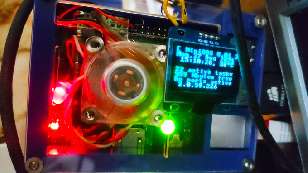Rick's b.log - 2021/12/27
You are 18.118.184.237, pleased to meet you!
Rick's b.log - 2021/12/27 |
|
| It is the 29th of April 2024 You are 18.118.184.237, pleased to meet you! |
|
mailto: blog -at- heyrick -dot- eu
It's a solid plastic box with transparent acrylic top and bottom. It comes with heatsinks for the major ICs. I added the copper heatsink to the memory on the underside, and the little heatsink to the USB and network device. I didn't need the CPU heatsink, one was already fitted.
I also transferred across the RTC and OLED panel from the Pi2, it was a simple matter of plugging it in and dropping the driver back into !Boot.Choices.Boot.Tasks so that it runs at startup.
The fan is quiet. I'm only running it on 3.3V, so it isn't going as fast as it could. On the other hand, it doesn't really seem to be moving any air. Maybe I will need to hook it up to run backwards? Questions I'll consider when it's warm enough to be a potential problem. Not that it'll be a real problem, mind you, as I have set my throttling to kick in at 55°C.
So I decided to try using a USB splitter to tap off a second socket for power, and then get a USB to barrel plug cable to try running the speakers. They're supposed to run off of 6V (1.5V × 4), but I would imagine there's enough leeway that 5V ought to work too. Typically these sorts of amplifier chips can run on "whatever" from about 4V to 9V, the main difference being how much it can move the speaker cone.
So it was all set up. A splitter allowed one USB socket to power both the speakers (which seemed quite happy with the 5V) and the NetRadio. The NetRadio powered up, connected to the Vonets AP, and...
...oh my god, what a horrible noise!
I could quite literally hear everything that was happening on the WiFi. I can only imagine that the ESP32 was spewing noise all over the place (the LCD backlight gently flickers along with WiFi bursts) which in this arrangement was badly affecting the speakers.
Running the speakers from a different power source made the problem go away, thankfully, so all is not lost. It does, though, point yet again to the batshit crazy power consumption of the ESP32. Either that, or the cheap-ass 5V to 3.3V convertor on the board. Either way, one clearly needs to take care in how these things are actually hooked up, in order to minimise unwanted noise.
Pi box
I bought a box for my Pi 3B+ from Amazon. Ordered it on Christmas Day, it was sent yesterday (Sunday!), and it arrived around 2pm. Uh, whoo.
CPUclock tells me the processor is running at 39°C, with the ambient inside being 22°C. I'm not sure I entirely trust that, as it's about 14°C in my room right now.
I did, however, have to mount the fan back to front because the people who design these cases never think to leave space for things that may be plugged into the GPIO to rest directly attached rather than using some sort of cable.

Pi 3B+ in it's new home.Speaker fail
My NetRadio is plugged into powered speakers in order to amplify the sound. They aren't anything speaker, just little ones with maybe 5cm speakers that are intended to sit either side of a monitor.
Normally they run on 4 C cells, but since I often forget to prod the power button, the batteries don't last so long.
Rick, 28th December 2021, 10:35
Never miss an opportunity to make another backup!J.G.Harston, 2nd January 2022, 03:54
Of course, as soon as I've done the backup it's out of date as I've been coding on one of the other machines on the network. ;)
| © 2021 Rick Murray |
This web page is licenced for your personal, private, non-commercial use only. No automated processing by advertising systems is permitted. RIPA notice: No consent is given for interception of page transmission. |